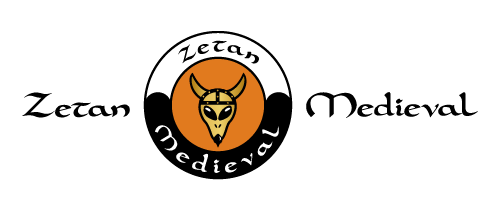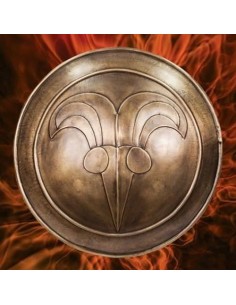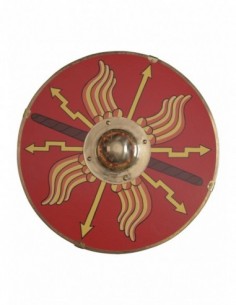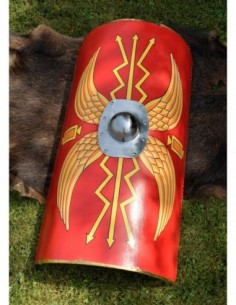BRIEF HISTORY OF THE ROMAN SHIELDS
scutum appears for the first time in the Republic , and from there, over the years we find ourselves with the typical rectangular shield used by Roman soldiers. Due to the materials with which these shields were made, very degradable materials over time, there are very few remains of the Roman shields that we can see today. Among these few remains we can mention the scutum shield of Dura Europos , which was a rectangular shield from imperial times.
We still do not know for sure the manufacturing method and the frame of the Roman shields. But thanks to the special dedication of some archaeologists, today we have more information about this exceptional defense element of the Roman legionnaire. Here we must mention that the shield was not only used defensively, but was also used as an offensive weapon, hitting enemies with its edges and the umbo.
The sources used by archaeologists to study the shields come from:
1.- Monuments and reliefs, which gave us an idea of its structure and composition.
2.- The legacies that the Roman writers left us, and
3.- Especially the archaeological findings.
In the early days of the Roman Republic, Roman soldiers formed phalanges and spearmen in the style of the Greek hoplites. So these Roman soldiers used a round shield called a clipeus . This type of round shield was very effective when formed as a phalanx, that is, in a closed and fixed manner. But the last Romans of the Republic are defeated by the Celts. After this harsh disaster, Rome stopped using the phalanx organization system, typical of the Greek hoplites, and used a new organizational method for its legions in maniples.
When the Celts from Breno defeated the Romans and launched themselves into the sack of the city in the year 387 BC. C., not only supposes a serious defeat for Rome, but also brings to light the defects of the Roman army, which becomes the need to submit it to a considerable reform if it wants to compete and return to being the first of the armies of the different towns of the time. These important reforms are applied by the consul Marco Furio Camilo, and reach the disposition, organization and armament of the Roman army. One of the transformations was to divide the troops into an organizational distribution of maniples independent of each other.
The reforms of the Roman army continue with the reforms of the year 315 BC-One of the important reforms was to organize the soldiers not by the census, but according to their experience in combat. It is in this period that the triarii (veteran legionnaires) substitute the clipeus for the scutum . Soon the princeps (second-line soldiers ) would do the same. The hastati (spearmen) used a semi-rectangular shield . Later we come across the type of shield known as a parma , a round shield used by signifiers (standard bearers) and velites (javelin throwers).
In its beginnings the scutum did not have the classic rectangular shape with which it has passed to our days, but this is a development of the elongated shield of the princeps and hastati , until advancing the centuries it reaches its final form. This long evolution ends with the so-called scutum augusta , in the first century at the time of Emperor Augustus.
The main difference between the scutum of the late Republic era, and the august scutum of the Empire consists in the suppression of the fusiform vertical prominence, in the imperial shield.
After Mario's reforms, the Roman army becomes more professional, and it is the state that provides the equipment to the soldier, breaking with what had been done previously, in which each soldier had to acquire his own weaponry . It is then when the shields begin to be mass-produced in a standardized way. This results in the shields having a stronger and better finished configuration.
During the Roman Civil War, the scuta already began to have its peculiar rectangular shape, curving and taking on the appearance of a semi-cylinder . In imperial times the curvature of the shield becomes smoother.
We know the structure of the republican scutum thanks to what Polybius wrote .
Its surface is convex and is two feet and a half (296 mm. Roman foot) wide and four feet long. Combines two glued boards, and protected by canvas and calfskin. All the edges are made of iron, a necessary element against the blows with the cuts of the swords. The convex is also covered with iron, as a means of defense against dangerous blows from pike stones or any hard element thrown with extreme violence. Their weight ranged between 7 and 10 kilograms. the scutum ideal guarded from the shoulder to the knee of the legionnaire. In the line formation, it also partly protected the line partner. Its curvature protected almost three quarters of the legionnaire's front, and almost all of his side, at the same time. The shield could also be used as an offensive weapon by hitting it with the umbo or the edges of the shield.
A very common component in Roman shields was the umbo (navel). This element was a metallic prominence and very resistant, located in the center of the shield, constituting an essential piece to use the shield as an offensive weapon, hitting the enemy that was approaching the Roman soldier from the side of the shield.
Another Roman shield is the parma and it is widely used in the middle of the Republic. Its shape is oval, its way of use among the legionnaires was in the manner of phalanxes, very similar to the way it was used by the Greek hoplites. They were smaller than scutums . Its diameter was three Roman feet (89 centimeters). They were built in a very similar way to the clipeus type shield , used in the period of the Roman Monarchy. In the center they had the umbo, which, as we have seen throughout this article, is a common element in all Roman shields.
The signifier , that is to say the soldier who carried the banners, carried a smaller parma -type shield called a parmula . It was used both in the Republic and in the Imperial era. This shield was also very famous among gladiators.
The auxiliaries and the velites , soldiers who carried javelins, usually used a parma , and with the passing of time, the velites began to use the parma shield exclusively.
The deterioration of the Roman Empire begins to be significant and unstoppable, after the crisis of the third century. In this state of affairs, the Romans began to reduce the equipment of the army, from which the shields were not spared. Gradually, the scutum began to be dispensed with and replaced by another shield similar to the parma . It was more oval and bigger. One of the causes was that the scutum needed a lot of training for its instruction, it also required a lot of complicity among the soldiers who used it. And this was impossible in the fourth century when the Roman Empire subordinated its defense, mostly, to mercenaries.
In training, the Romans used wooden swords , incompatible with the hard scuta , since wooden swords broke easily when hitting this shield. In its place, some shields made of wicker were used . Of course, its dimensions were practically the same as the shields used in battles. Another reason to use wicker in training shields is that in combat, the shield was also an offensive weapon, and if you hit your training partner with a battle shield, you could seriously injure him. However, it seems that the wicker shields were used in the fight in the pre-republican era , but it must also be said that this situation occurred very rarely, and always in cases of emergency, since there was no other shield available. hand.
WHAT THE ROMAN SPEARS WERE LIKE
The Roman spear was called a pilum and it was not a weapon used in hand-to-hand combat, but was used as a thrown weapon by the Roman infantry. It had a high weight, but its advantages were such that it was used by the Romans for five centuries. He measured between 152 and 213 centimeters. Two parts can be distinguished in the pilum . The lower part was called an antler , and it was made of wood. The upper zone of the pilum was called the moharra , and it was the fearsome part. This part was metallic and two parts can be distinguished, a long one from 60 to 90 centimeters, and the tip of 5 centimeters. It was launched against the enemy from 5 to 20 meters and was capable of piercing armor. The Praetorians had the habit of differentiating their pilum , and they used to decorate these with an eagle-shaped drawing.
The lance or light javelin was another thrown weapon used at first by the infantry and the Roman light cavalry, but later it replaced the pilum , as the lance offered more advantages in battle compared to the pilum . The only ones who did not join the change were the components of the Praetorian Guard, although around the 3rd century they gave up and joined the general trend. The lancea was smaller in weight than the pilum . Due to this he could reach much greater distances than his older brother. A curiosity is that it could be launched with a leather strap propellant, known as an amentum . It was divided into three parts, the iron tip, the central part of wood or horn, and at the bottom an iron cone, called a spike.
HISTORY OF THE GREEK SHIELDS
Already in the Bronze Age we can find Greek shields in the Aegean Sea. They were large and rectangular that protected from the neck to the shins. These tower shields had a wicker structure covered with animal skins. Coexistence with long spears suggests a shoulder-to-shoulder mode of combat. In the 13th century BC, new shield models arrived, small in size with a round silhouette; and, finally, due to the change in combat modes, in an open way, pelta shields, round but endowed with a notch on the edge. Another type of shield is the eight-shaped one, made of bovine leather.
In the second half of the 8th century BC we see representations of warriors with large oval shields with two lateral slits. It is known as e45. Some researchers doubt their existence as no remains of them have appeared.
Between the 8th and 4th centuries BC, the Greeks developed a type of shoulder-to-shoulder combat, in which the round shield stands out, called aspis . Its core was made of wood and had a revolutionary grip shape, designed to protect the warrior and whoever was on his left. This way of fighting due to the shape of the shield gave the Greeks a great advantage over their opponents.
In the fourth century a new type of soldier arose. He carries a long pike that needs his arms to hold it, so the aspis shield is no longer useful, so the warrior is endowed with a circular shield, but much smaller. This example of a soldier is the one that constitutes the central axis of the Macedonian phalanxes, which achieved so many victories for Alexander the Great.
Fundamental in the wars of Antiquity, as a defensive unit, the shield was used by the warriors of all the peoples of that time and, of course, ancient Greece would not be an exception to such a statement. It was used in all his armed confrontations and, naturally, in his most famous battles such as the battle of Marathon, Thermopylae and Plataea . In addition to its mainly defensive character, the shield was also used as an offensive weapon, striking with its edges or throwing them at the enemy. The shields, like other weapons, have undergone modifications over the years, in terms of their shape and their use to adapt to different ways of fighting, or because of new military strategies.
THE MOST FAMOUS AND USED GREEK SHIELDS
The most common Greek shields were the aspis and the hoplon :
The aspis was a round shield of bronze or wood covered with leather. It comprised a diameter of between 60 and 90 centimeters, and its weight was approximately around 5 kilos. The aspis was carried on the left arm of the warrior and on the inside it had a leather strap to facilitate the grip. In addition, in the outer central part, the shield had an umbo with which they hit the opponents. It was used by the hoplites, the Greek heavy infantry. It offered great protection, since it practically covered the entire body of the soldier. One way of attacking the hoplites was in the form of a phalanx, forming rows or columns protecting each other with their shields. The result was a kind of wall that was very difficult for the enemy to break through. Some warriors adorned their shields with engravings.
The hoplon was a large, heavy shield made of leather-covered plywood and bronze. Designed in the shape of a circle that was split in the lower area to better adapt to the shape of the wearer. It was customary for it to have a crest in the center. It was also not uncommon to see these shields painted with sophisticated motifs. The hoplon measured between 80 and 120 centimeters in diameter, and weighed between 7 and 10 kilos. It was carried by the heaviest and most experienced warriors. As it almost totally covered the soldier's body, the hoplon was a very valid device to stop the arrows or spears that came from the opposite field. Another remarkable feature of the hoplon is that with the central ridge it could hit the attacker with more force.
Although the two shields described above were the most used by Greek warriors, there were others at that time, such as:
OTHER TYPES OF SHIELDS OF ANCIENT GREECE
Thureos : Rectangular shield with rounded edges, typical of Thracian warriors. Less heavy than the hoplon and the aspis, its structure was made of wood covered with leather. It was very common for the warrior to add some kind of decoration to the shield.
Pelte : Small round shield typical of the Greek mercenaries. It measured between 30 and 45 centimeters in diameter and had a grip on the back to hold it and a strap to hook it to the wearer's arm.
Argive Aspis : Wielded by the warriors of the city-state of Argos. Like other shields of the time, it had a raised plume in the center and a slit in the lower area to condition the arm. It is normally covered in bronze and decorated with prints of animals and fabulous beings.
Arcadian Pelte : Round shield, used by the warriors of the city-state of Arcadia. Smaller than the normal pelt , it was around 30 cm in diameter, made of wood and covered in goatskin. Light weight was used as a means of protection against projectiles received from the opponent.
Aspis of the Royal Guard of Thebes : Shield also round, used by the Royal Guard of Thebes. Larger than the common aspis , it measured 1 meter in diameter. Made of wood and covered with oxhide, like other shields of the time, it is profusely decorated.
Thessalian Pelte : Round shield, used by Thessalian warriors. Larger than the normal pelte , it measured 60 cm. in diameter, was made covered with leather and decorated
Argive hoplon : Used by the warriors of the city-state of Argos. It was a variety of the normal hoplon .
Pelta : Round shield, used by the warriors of the Macedonian city-state, it was very similar to the common pelte , and somewhat larger. It was decorated with silver ornaments.
Oxhide shield : Used by the Mycenaean warriors in the Bronze Age, it was made of oxhide. Rectangular in shape with rounded edges. Smaller than the shields of classical Greece. Still, it offered good protection.
The great variety of shields in Ancient Greece was explained by the cultural differences between the Greek city-states. Their name varied according to the region or the time in which they were used.


















